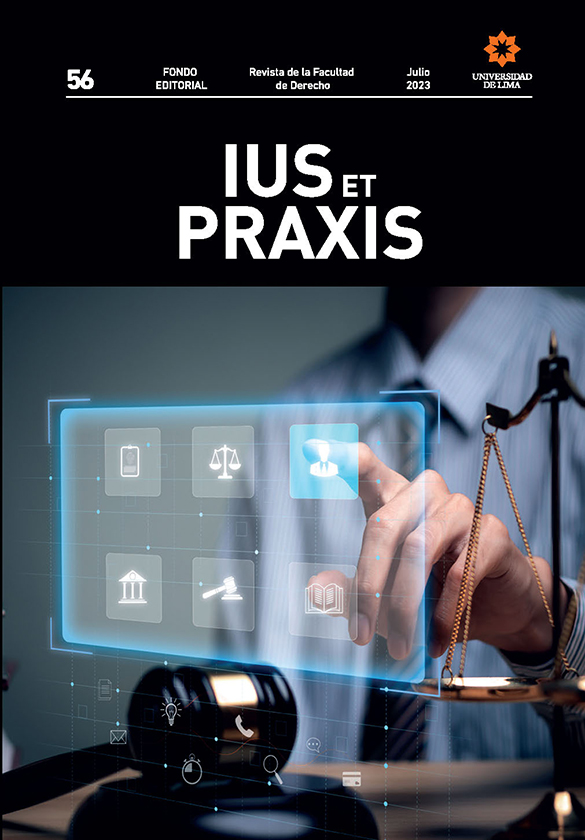The world of the unequal
DOI:
https://doi.org/10.26439/iusetpraxis2023.n056.6402Keywords:
transhumanism, bioethics, biolaw, dehumanization, human beingAbstract
This research article will deal with a highly controversial topic: transhumanism. The author will analyze the problems that this scientific-ideological movement would entail if it actually carried out its ideas in reality. This analysis will be done from both a bioethical and a legal perspective since the theoretical knowledge that bioethics offers us is insufficient and needs to be put into practice in reality since the legal system must recognize such transcendental issues that are drawing more and more attention. Finally, the author will provide some possible solutions that should be considered if this ideology is to be stopped. It should be noted that the developed solutions are only a few, so it should not be understood that the solutions are limited to those set-out.
Downloads
References
Bostrom, N. (2021). ¿Qué es el transhumanismo? (P. Gayozzo & F. López De Pomar, Trad.). Futuro hoy, 2(2), 7-12 (Trabajo publicado en 2001). https://doi.org/10.52749/fh.v2i2.1
Burgos, J. M. (2013). ¿Qué es la bioética personalista? Un análisis de su especificidad y de sus fundamentos teóricos. Cuadernos de Bioética, 24(80), 17-30. http://aebioetica.org/revistas/2013/24/80/17.pdf
Calcagno, J., & Fuentes, A. (2012). What makes us human? Answers from evolutionary Anthropology. Evolutionary Anthropology, 21(5), 182-194. https://doi.org/10.1002/evan.21328
Cárdenas Krenz, R. (2006). La teoría del caos y su aplicabilidad para el análisis y la comprensión de los fenómenos jurídicos. En Universidad de Lima (Ed.), Libro homenaje Facultad de Derecho (pp. 213-238). Fondo Editorial de la Universidad de Lima.
Castellanos Claramunt, J. (2018). Transhumanismo, algoritmos y nuevas tecnologías: avanzando en la desigualdad. Ius et Scientia, 4(2), 120-131. http://dx.doi.org/10.12795/IESTSCIENTIA.2018.i02.08
Cortina, A. (2010, 29 de julio). ¿Tienen derechos los animales? El País. https://elpais.com/diario/2010/07/29/opinion/1280354405_850215.html
Expósito Serrano, A. (2017, 1 de febrero). Transhumanism: biological and epistemological implications. https://ssrn.com/abstract=2908821
Fukuyama, F. (2002). El fin del hombre. Consecuencias de la revolución biotecnológica. Ediciones B.
Ginés, P. J. (2021, 31 de agosto). Transhumanismo y biotecnología: lo posible, las fantasías, peligros y límites de ser “mejorado”. Religión en libertad. https://www.religionenlibertad.com/ciencia_y_fe/55071804/transhumanismobiotecnologia-peligros-enhancement.html?fbclid=IwAR2uWQOpbjW8deLySEa9aeaBp856rD9xmkmpJAungrefi34BSFJEX_FmK9U
Gutiérrez Samperio, C., & Vila-Coro, M. (2007). Bioética y biojurídica. Medicina y Ética: Revista Internacional de Bioética, Deontología y Ética Médica, 18(1), 53-70. https://revistas.anahuac.mx/bioetica/issue/view/64
Heredia González, D. (2018). ¿Qué constituye al ser humano como ser humano? Un intento de tomar parte en la búsqueda a una pregunta básica del quehacer filosófico. Naturaleza y Libertad. Revista de Estudios Interdisciplinares, (10), 143-154. https://doi.org/10.24310/nyl.v10i3.3664
Herrero Jaén, S. (2016). Formalización del concepto de salud a través de la lógica: impacto del lenguaje formal en las ciencias de la salud. Ene. Revista de Enfermería, 10(2). https://scielo.isciii.es/scielo.php?script=sci_arttext&pid=S1988-348X2016000200006
Hriscu, M. (2020, junio). The challenges of transhumanism and human rights reflected in the current Romanian constitutional provisions. International Journal of Communication Research, 10(2), 198-201. https://www.ijcr.eu/articole/502_014%20Marius%20HRISCU.pdf
Kaelber, L. (2012). Virginia. Eugenics: compulsory sterilization in 50 American States. https://www.uvm.edu/~lkaelber/eugenics/VA/VA.html
Kinghorn, K. (2010). Cuestiones de identidad: ¿es el increíble Hulk la misma persona que Bruce Banner? En T. Morris & M. Morris (Eds.), Los superhéroes y la filosofía: la verdad, la justicia y el modo socrático (pp. 339-356). Blackie Books.
Lima, L. (2021, 4 de febrero). La distribución desigual de vacunas entre países ricos y pobres significará que el virus continuará propagándose y mutando. BBC News Mundo. https://www.bbc.com/mundo/noticias-55911364
Lomanno, M. P. (2008). The possibilities and problems of transhumanism. National Catholic Bioethics, 8(1), 57-66.
López Barahona, M., & Abellán, J. C. (2009). Los códigos de la vida. Homolegens.Machado, A. (1958). Hoy es siempre todavía.
Michigan State University. (s. f.). What is bioethics? Center for Bioethics and Social Justice. https://bioethics.msu.edu/what-is-bioethics.
Nombela, C. (2018, 29 de abril). Transhumanismo y eugenesia. ABC. https://www.abc.es/sociedad/abci-transhumanismo-y-eugenesia-201804292054_noticia.html
Ortiz, M. (2021). Libro Un mundo feliz de Aldous Huxley. Cultura Genial. https://www.culturagenial.com/es/libro-un-mundo-feliz-de-aldous-huxley/
Porter, A. (2017). Bioethics and transhumanism. Journal of Medicine and Philosophy, 42(3),237-260. https://doi.org/10.1093/jmp/jhx001
Real Academia Española. (2001). Enfermedad. En Diccionario de la Real Academia Española. https://www.rae.es/drae2001/enfermedad
Real Academia Española. (s. f.). Desnaturalizar. En Diccionario de la Real Academia Española. https://dle.rae.es/desnaturalizar
Real Academia Española. (s. f.). Esencia. En Diccionario de la Real Academia Española. https://dle.rae.es/esencia?m=form
Real Academia Española. (s. f.). Sanar. En Diccionario de la Real Academia Española. https://dle.rae.es/sanar?m=form
Rendtorff, J. D. (1998). Basic principles in bioethics and biolaw. Bioethics and Medical Ethics, 130-142. http://www.bu.edu/wcp/Papers/Bioe/BioeRend.htm
Sandberg, A. (2014). Transhumanism and the meaning of life (pp. 1-20). http://smile.amazon.com/Religion-Transhumanism-Future-Human-Enhancement/dp/1440833257/ref=sr_1_fkmr0_1?ie=UTF8&qid=1455566547&sr=8-1-fkmr0&keywords=Transhumanism+and+Religion%3A+Moving+into+an+Unknown+Future&tag=s4charity-20
Schneider, S. (2008). Future minds: transhumanism, cognitive enhancement and the nature of persons. https://repository.upenn.edu/neuroethics_pubs/37
Spaemann, R. (1997). ¿Es todo ser humano una persona? Persona y Derecho, (37), 9-23. https://doi.org/10.15581/011.32013
TED-Ed. (2020, 27 de abril). The dark history of IQ tests - Stefan C. Dombrowski. [Video]. Youtube. https://www.youtube.com/watch?v=W2bKaw2AJxs
Villarroel, R. (2015). Consideraciones bioéticas y biopolíticas acerca del transhumanismo. El debate en torno a una posible experiencia posthumana. Revista de Filosofía, 71, 177-190. http://dx.doi.org/10.4067/S0718-43602015000100014
Virginia Sterilization Act. (1924, 20 de marzo). Asamblea General de Virginia. World Transhumanist Association. (1998). The transhumanist declaration. https://web.archive.org/web/20090512213327/http://transhumanism.org/index.php/WTA/declaration


